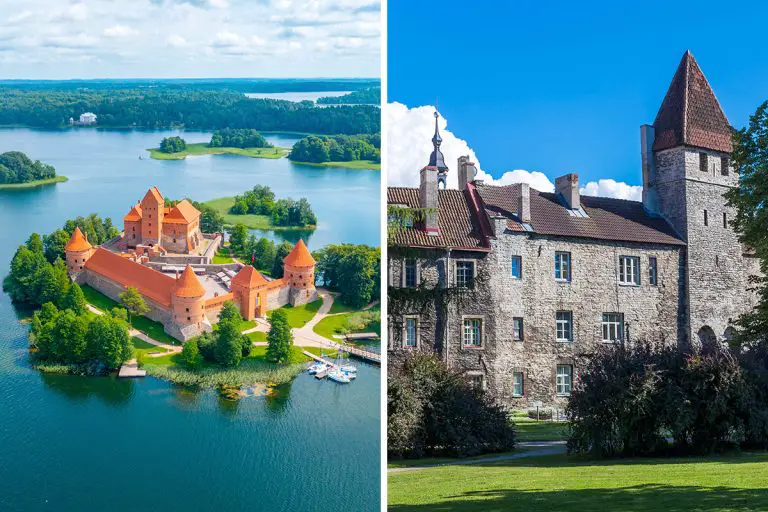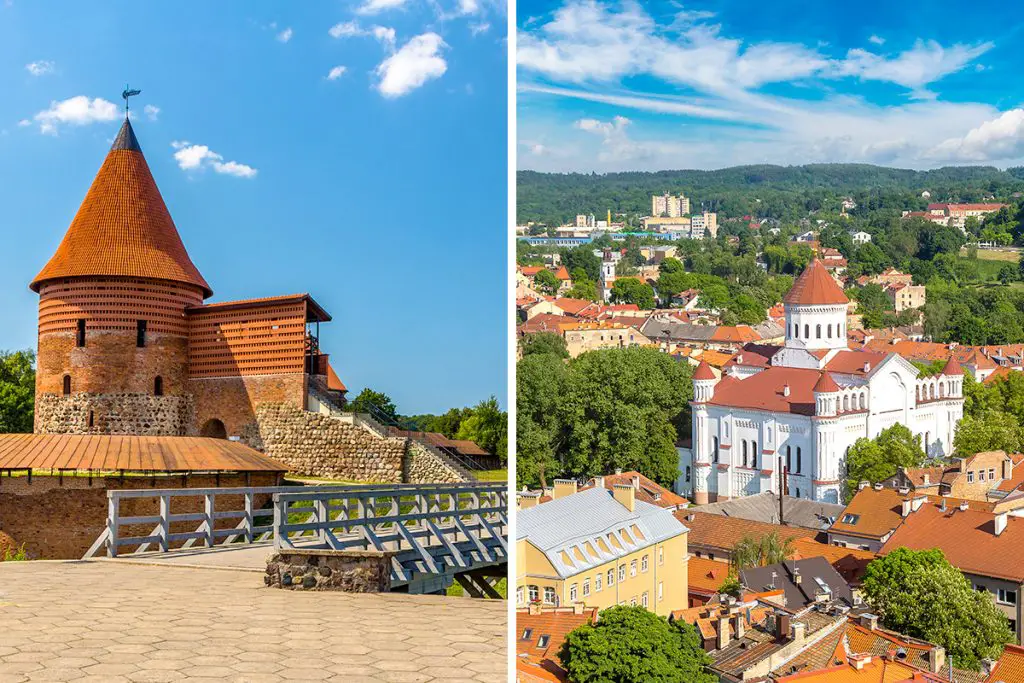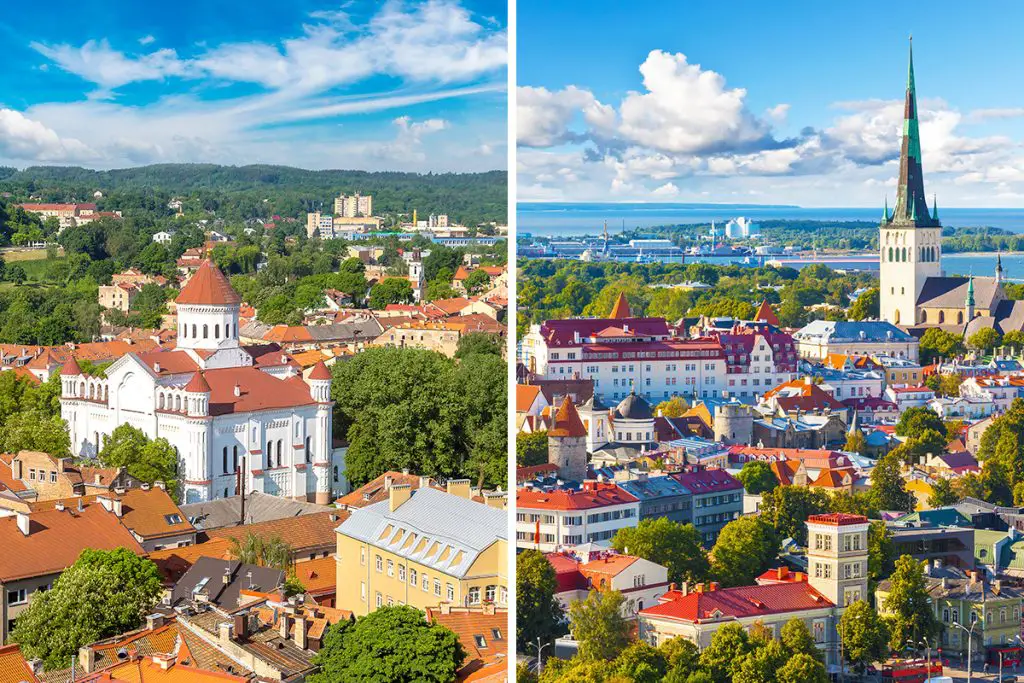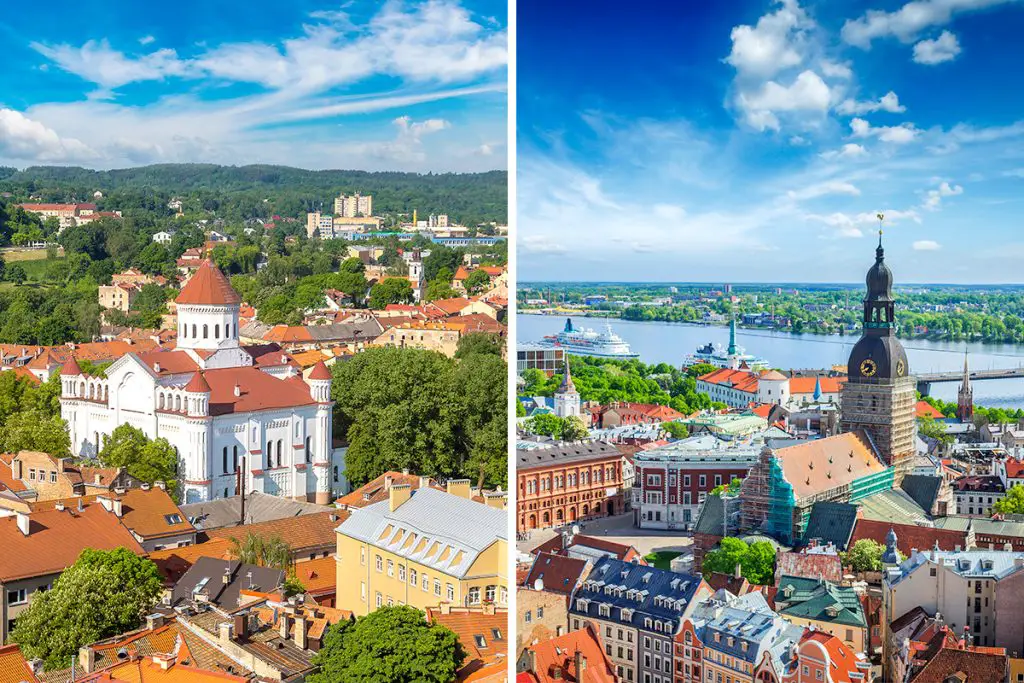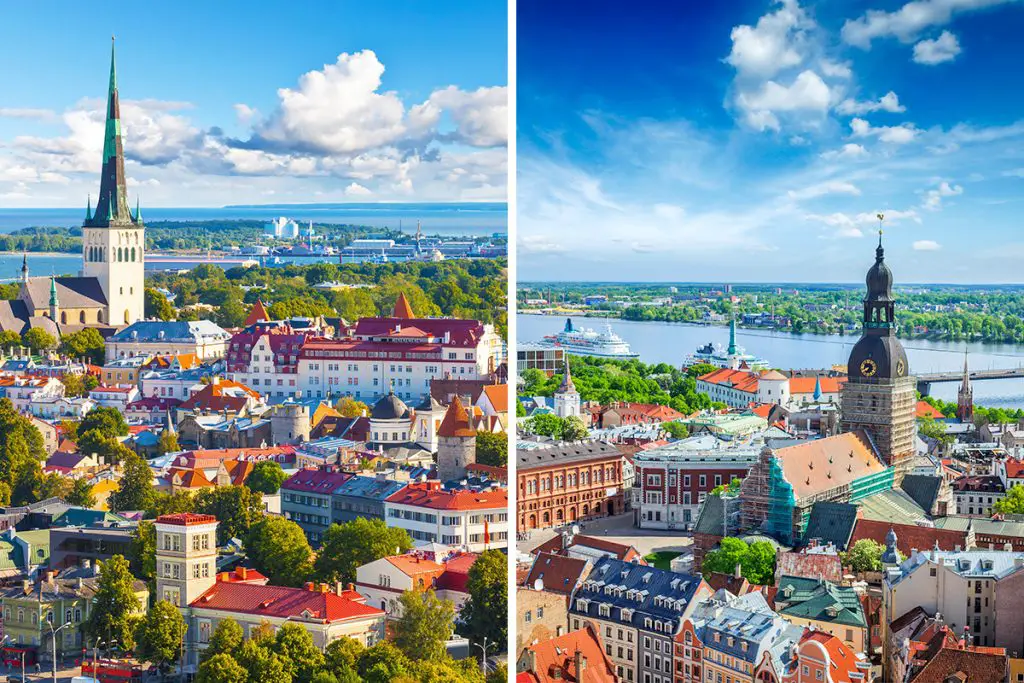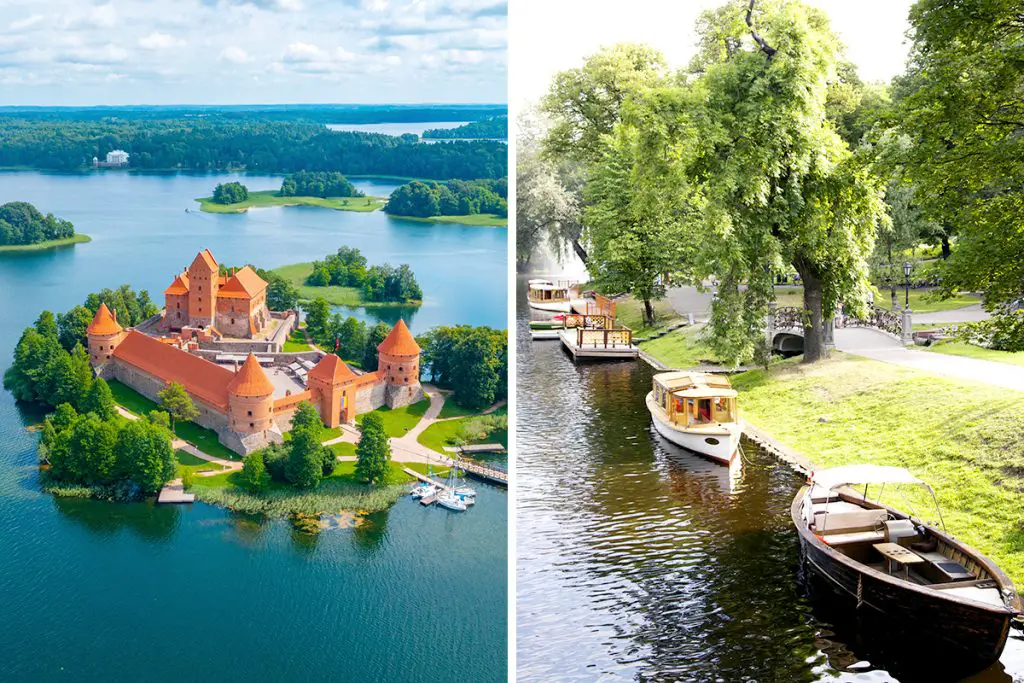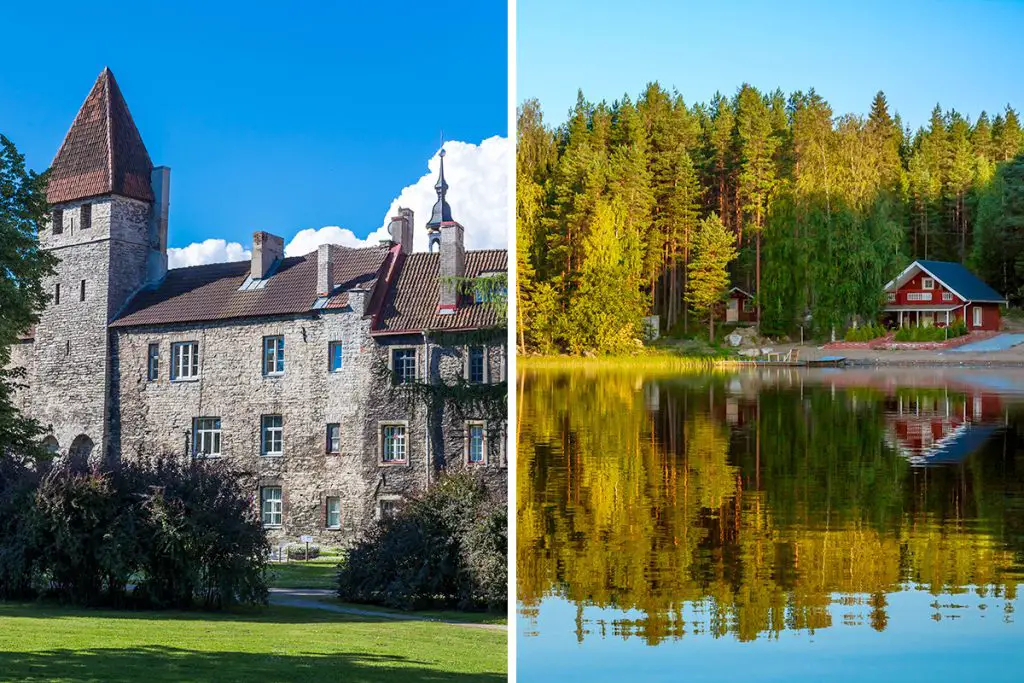Trying to narrow down your travel options can feel like an exciting challenge. Whether you’re into learning about the past or exploring what’s cutting-edge, these two destinations have got something for you. Intrigued? Keep reading to find out more!
History & Culture
So you want to soak up some history and culture on your trip, huh? Well, both Lithuania and Estonia are treasure troves in this department. But they offer different kinds of riches. Let’s dig in and see how they compare.
First up is Lithuania. Imagine a country that’s like an old, wise storyteller. Lithuania has a long, complex history filled with knights, castles, and folklore. It was once a mighty kingdom that even stretched into present-day Russia. The country is proud of its traditions, from folk dances to ancient festivals. Lithuania is a place where the past feels alive.
Now, let’s talk about Estonia. Think of it as a tech-savvy teenager who’s super into the future but still respects its roots. Estonia is one of the most digitally advanced countries in the world. They vote online and even have e-residency! But don’t let that fool you. Estonia also has a rich past, complete with medieval architecture and traditions that go back centuries.
So how are they different? Well, Lithuania tends to focus more on preserving its past. Think of it like a museum where you can walk around and almost touch history. Estonia, on the other hand, mixes the old with the new. It’s like a modern art gallery that also has some classic paintings.
In terms of language and traditions, both countries are distinct. Lithuanian and Estonian languages are not very similar, even though both countries are in the same neighborhood. In Lithuania, you’ll find more influences from Poland and Russia. In Estonia, there’s a stronger connection to Finland and the Nordic countries.
To sum it up, if you’re a history buff who loves to dive deep into traditions, Lithuania might be your pick. But if you’re excited by the blend of old and new, Estonia’s dynamic culture will likely capture your interest. Either way, you’re in for a cultural feast that will make your trip unforgettable. So, what’ll it be?
Attractions & Activities
Ready to explore and have some fun? Lithuania and Estonia offer plenty of ways to make your trip memorable, each with its own set of unique attractions and activities. Let’s jump in and find out what makes each destination special in this area.
In Lithuania, how about taking a scenic hot air balloon ride over the capital city of Vilnius? It’s one of the few European cities where hot air ballooning is allowed, giving you a bird’s-eye view of its historical sites and beautiful landscapes.
For a taste of nature, visit the Aukštaitija National Park. It’s perfect for hiking and kayaking, and you’ll get to see some charming wooden churches too.
Over in Estonia, the capital city of Tallinn offers something unique—a walk along its medieval walls. These ancient fortifications give you great views and a feel for the city’s rich history. If you’re into adventure, why not go bogs-shoeing in the Soomaa National Park? You’ll walk on floating platforms over the wetlands, making it an experience unlike any other.
Lithuania’s attractions are more diverse, with a blend of history, nature, and even adrenaline-pumping experiences. It offers you the chance to not only see but feel the pulse of the country. Estonia focuses more on its unique landscapes and historical sites, providing activities that allow you to immerse yourself in its rich past and scenic beauty. So, where will your adventures take you?
Beaches
Are you a beach lover? Well, Lithuania and Estonia have got something for you, but their offerings are as different as night and day. Let’s see how their beaches stack up against each other.
Firstly, Lithuania boasts the Curonian Spit, a narrow strip of land with dunes that can reach up to 60 meters (about 197 feet) high! This UNESCO World Heritage Site is about 98 kilometers (about 61 miles) long and offers a unique beach experience surrounded by towering dunes and pine forests.
On the Estonian side, there’s Pärnu Beach, known for its shallow waters and soft, golden sands. The beach is approximately 2 kilometers (about 1.2 miles) long and is great for a relaxed day out, especially if you enjoy calmer waters and less crowded spaces.
So what sets them apart? Lithuania’s Curonian Spit offers a blend of beach and nature experiences. You’re not just going to the beach; you’re going on a natural adventure. Estonia’s Pärnu Beach, on the other hand, offers a more traditional beach experience, where the focus is on the sea and sand.
In terms of the beach vibes, Lithuania gives you a sense of seclusion and wonder, making you feel like you’re part of something grand in nature. Estonia offers a more typical beach atmosphere, where the water plays the main role, and the surroundings complement it.
In summary, Lithuania’s Curonian Spit is for those who want to combine beach fun with a touch of nature and adventure. Estonia’s Pärnu Beach is ideal if you’re looking for a more straightforward, chill beach experience. Each has its own unique charm, but which one calls to you?
Eating, Drinking & Nightlife
Hungry for some local flavors or eager to dance the night away? Lithuania and Estonia offer a variety of options when it comes to eating, drinking, and nightlife. Let’s dive into what each country brings to the table.
In Lithuania, you’ll find a hearty and earthy cuisine. Dishes like “cepelinai,” potato dumplings stuffed with meat, or “šaltibarščiai,” a cold beetroot soup, are staples. If you’re a meat lover, Lithuania is going to feel like a food paradise.
On the drink front, Lithuania is famous for its beer, with microbreweries and local pubs showcasing a wide range of options. So, whether you like it light or dark, you’ll find something to tickle your taste buds.
In Estonia, the cuisine is influenced by its Nordic neighbors. You’ll encounter dishes like “sült,” a jellied meat dish, and “kama,” a grain dessert. The country also offers some fabulous seafood options thanks to its location near the Baltic Sea. As for drinks, Estonia takes pride in its vodka. Many local varieties use unique filtering techniques, offering a smooth and distinct taste.
When it comes to nightlife, Lithuania offers an eclectic mix of options from vibrant clubs playing electronic music to more relaxed jazz bars. The country’s large student population ensures a lively scene, especially in cities like Vilnius and Kaunas.
Estonia’s nightlife, on the other hand, is more about chic venues. Tallinn is the hub for this, with plenty of stylish cocktail bars and nightclubs that play a mix of top 40 hits and EDM. It’s a little more upscale compared to Lithuania but equally engaging.
To sum it up, Lithuania offers hearty meals and a beer-centric drinking culture with a mix of lively nightlife venues. Estonia leans more towards Nordic-inspired cuisine, a vodka-loving drinking culture, and a trendy nightlife scene. Whatever your tastes, both countries have something to offer that will make your nights as memorable as your days.
Shopping
Ready to go on a shopping spree? Both Lithuania and Estonia offer a range of shopping experiences that reflect their unique cultures and styles. Let’s see how they match up.
In Lithuania, you can explore markets like the Hales Turgus in Vilnius, where you can buy everything from local cheese to handmade crafts. The country is also famous for its amber jewelry, which makes for a special keepsake. If you’re into fashion, you’ll find several boutiques featuring local Lithuanian designers.
Estonia offers a different vibe. Head to the Rotermann Quarter in Tallinn, where old industrial buildings have been transformed into chic shops and boutiques. Estonia is known for its digital culture, and that extends to its shopping experience as well. You’ll find a plethora of tech shops selling everything from the latest gadgets to niche electronic accessories.
Lithuania’s shopping scene offers a blend of traditional and modern, with an emphasis on local crafts and food items. Estonia, on the other hand, gives you a more contemporary shopping experience, heavily influenced by its tech-savvy culture.
In conclusion, whether you’re hunting for traditional crafts in Lithuania or cutting-edge gadgets in Estonia, both countries offer compelling shopping experiences that reflect their unique cultural identities. So, which one will you pick for your next retail adventure?
Accommodation
Looking for a cozy spot to rest your head while exploring Lithuania and Estonia? Both countries offer a range of accommodation options that suit different travel styles. Let’s see what each has to offer.
Lithuania is rich in variety, offering everything from traditional wooden cottages in the countryside to modern hotels in the city. In Vilnius, you can even stay in restored historical buildings that give you a feeling of stepping back in time. Want something unique? Consider booking a night in a castle for a truly royal experience.
Estonia, on the other hand, excels in boutique hotels, especially in its capital city, Tallinn. Many of these are set in medieval buildings, complete with stone walls and wooden beams. For nature lovers, Estonia also offers several eco-friendly accommodations that allow you to be one with nature without sacrificing comfort.
Lithuania gives you a taste of both the old and the new, allowing you to choose accommodations that fit the kind of experience you’re after. Estonia leans more toward intimate, unique experiences, particularly through its boutique hotels and eco-friendly lodgings.
In summary, Lithuania offers a wide array of options ranging from traditional to modern, while Estonia tends to focus on more unique, intimate stays. Depending on what you’re looking for, each country has something special to make your stay memorable.
Family-Friendliness & Children’s Activities
Traveling with your family and wondering what Lithuania and Estonia have in store for you? Both countries are packed with activities that are fun for kids and adults alike. Let’s dive in!
Lithuania offers several interactive museums designed to educate and entertain children. There are also many outdoor parks with playgrounds and nature trails ideal for family walks. Activities like berry picking in the forest can be a delightful way for kids to connect with nature.
In Estonia, there are many child-friendly museums and workshops, especially in Tallinn. Kids can participate in art and craft workshops, and even traditional Estonian cooking classes. Outdoor skating rinks in winter and paddle boating in summer are activities that both kids and parents can enjoy.
Both countries offer several annual festivals that are family-friendly. In Lithuania, festivals often include games, folk music, and dance that invite participation from young ones. Estonia has film festivals and seasonal fairs that offer puppet shows and magic performances designed for children.
Lithuania leans more toward outdoor activities, making the most of its natural landscapes to offer family fun. Estonia focuses on structured, educational activities and cultural experiences that are as entertaining as they are enlightening.
To sum it all up, Lithuania and Estonia offer different but equally fun and educational experiences for families. Whether you prefer outdoor adventures in Lithuania or cultural experiences in Estonia, both countries have a lot to keep your family entertained.
Getting There & Getting Around
So, you’ve picked your destination, but how easy is it to get there and move around? Both Lithuania and Estonia have their own perks and quirks when it comes to transportation. Let’s break it down.
To get to Lithuania, most international travelers fly into Vilnius International Airport. The airport is around 6 kilometers (about 3.7 miles) from the city center. Estonia’s main international gateway is Lennart Meri Tallinn Airport, situated about 5 kilometers (around 3.1 miles) from central Tallinn.
In Lithuania, public buses and trolleys are popular means of transport within the cities. For longer distances, you can take the train or rent a car. If you’re staying in Vilnius, consider using bike rentals, which are an eco-friendly way to see the city.
Estonia offers trams and buses in Tallinn, and in other cities, buses are the main form of public transport. Just like in Lithuania, trains are available for long-distance travel. However, in Estonia, you’ll also find a well-organized network of ferries that can take you to various islands.
In conclusion, both countries are quite accessible and offer multiple modes of transportation for getting around. Whether you prefer the bike-friendly streets of Vilnius or the ferry networks of Estonia, you’re unlikely to have any problems navigating either country. So, which one aligns better with your travel style?
Weather
Weather is a key factor when planning a trip, right? You’d like to know if you’ll be needing sunscreen or a winter coat. Well, Lithuania and Estonia, located in Northern Europe, have similar climates but with some differences worth noting.
In Lithuania, winters are cold and can dip to as low as 14°F (-10°C) from December to February. On the flip side, summers are mild to warm, with temperatures usually ranging from 60°F to 75°F (16°C to 24°C) between June and August. You can expect a fair amount of rainfall, especially in August.
Estonia also experiences cold winters but they are generally milder compared to Lithuania. From December to February, the temperatures hover around 20°F to 30°F (-7°C to -1°C). Summers are quite similar, ranging between 60°F and 70°F (16°C to 21°C), with July being the warmest month.
Both countries have relatively short springs and autumns, offering beautiful natural landscapes. Lithuania’s autumn months, September and October, showcase stunning foliage, while Estonia’s spring months, particularly May, feature a wealth of blooming flowers.
In summary, whether you prefer the chilly adventures of a Baltic winter or the mild comfort of a summer trip, both Lithuania and Estonia offer something for you. Just pack accordingly!
Safety
Safety is a top concern when you’re deciding where to go, isn’t it? Let’s look at how Lithuania and Estonia measure up on this front.
In general, Lithuania is considered a safe country for travelers. Violent crime is rare, and petty crime like pickpocketing is mostly limited to busy tourist areas. Police presence is usually visible, especially in the cities.
Estonia also ranks high on the safety scale. The country is known for its low crime rate, and violent incidents involving tourists are extremely rare. Like in Lithuania, pickpocketing can occur in crowded places but is not common.
Beyond crime, Lithuania offers excellent healthcare services, with many medical facilities and pharmacies readily available. Estonia is noted for its cleanliness, and you’ll find well-maintained public spaces and utilities, which also contribute to overall safety.
To sum up, both Lithuania and Estonia offer a safe environment for travelers, but each has its unique advantages. Whether you value healthcare options or spotless surroundings, you’ll find these countries well-prepared to offer you a secure visit.
Cost
When you’re planning your trip, you’ll want to know how much to budget, right? So let’s take a look at how Lithuania and Estonia stack up in terms of cost.
Lithuania is generally more budget-friendly than Estonia. A meal at a mid-range restaurant in Vilnius, Lithuania’s capital, might cost you around 25 Euros ($26.50-$27.00). Local transportation is also affordable, with a single bus ticket priced at about 1 Euro ($1.00-$1.50).
In contrast, Estonia is a bit pricier, especially in its capital, Tallinn. A meal at a similar mid-range restaurant could set you back 28 Euros ($29.50-$31.00). Local bus tickets in Tallinn cost around 2 Euros ($2.00-$2.50).
Both countries offer a range of lodging options. In Lithuania, you can find 3-star hotels averaging 80 US Dollars per night, while in Estonia, accommodations average around 90 US Dollars per night.
In summary, while both Lithuania and Estonia offer a wide range of options for different budgets, Lithuania is generally more affordable, especially for food and transportation. Choose accordingly based on what you’re willing to spend!
Which Is Better – Lithuania or Estonia?
Choosing between Lithuania and Estonia can be like picking a favorite flavor of ice cream—each has its own unique charm and appeal. Both countries offer rich experiences in history, culture, activities, and so much more. Let’s revisit what sets each destination apart to help you make your decision.
When it comes to history and culture, Lithuania has a deep-rooted heritage showcased through its architecture and folklore. Estonia, on the other hand, offers a mix of ancient traditions and modern influences, making it a melting pot of past and present. If you’re a history buff, Lithuania might call out to you a bit more.
As for attractions and activities, Lithuania generally offers more budget-friendly options. However, Estonia takes the cake for variety, offering a broader range of experiences. If you’re looking for diversity in your itinerary, Estonia could be your go-to destination.
In terms of beaches, both countries offer unique coastal experiences, but if milder winters are more your style, then Estonia’s beaches might be more enjoyable for you. Lithuania’s beaches have their own charm but tend to have colder winters.
When it comes to eating, drinking, and nightlife, both countries have vibrant scenes, but Estonia tends to be on the pricier side. Lithuania offers similar experiences but at a more wallet-friendly rate. If budget is a significant factor for you, Lithuania is the better option in this category.
If shopping is your passion, you’ll find Estonia a bit more to your liking with its range of high-end boutiques and artisan stores. Lithuania offers shopping experiences too, but leans more toward local markets and smaller shops. If you’re after unique, hand-crafted items, Estonia could be your shopping paradise.
Family-friendliness and children’s activities are abundant in both countries. However, Lithuania offers more affordable options, making it more suitable for families on a budget. Estonia also provides excellent family-centric activities but can be pricier.
To sum it up, if you’re looking for a destination rich in history and culture that won’t break the bank, Lithuania could be the place for you. If you prefer a broader range of activities, milder beaches, and a flair for the high-end, Estonia would be your best bet. Ultimately, the best choice depends on what you value most in your travel experiences.

